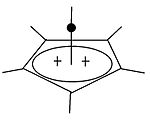Carbonium ion

In chemistry, a carbonium ion is a cation that has a pentacoordinated carbon atom.[2] They are a type of carbocation. In older literature, the name "carbonium ion" was used for what is today called carbenium. Carbonium ions charge is delocalized in three-center, two-electron bonds. The more stable members are often bi- or polycyclic.[3]
2-Norbornyl cation
[edit]The 2-Norbornyl cation is one of the best characterized carbonium ion. It is the prototype for non-classical ions. As indicated first by low-temperature NMR spectroscopy and confirmed by X-ray crystallography,[1] it has a symmetric structure with an RCH2+ group bonded to an alkene group, stabilized by a bicyclic structure.
Cyclopropylmethyl cation
[edit]A non-classical structure for C
4H+
7 is supported by substantial experimental evidence from solvolysis experiments and NMR studies. One or both of two structures, the cyclopropylcarbinyl cation and the bicyclobutonium cation, were invoked to account for the observed reactivity. he NMR spectrum consists of two 13C NMR signals, even at temperatures as low as −132 °C. Computations suggest that the energetic landscape of the C
4H+
7 system is very flat. The bicyclobutonium structure is computed to be 0.4 kcal/mol more stable than the cyclopropylcarbinyl structure. In the solution phase (SbF5·SO2ClF·SO2F2, with SbF–
6 as the counterion), the bicyclobutonium structure predominates over the cyclopropylcarbinyl structure in a 84:16 ratio at −61 °C. Three other possible structures, two classical structures (the homoallyl cation and cyclobutyl cation) and a more highly delocalized non-classical structure (the tricyclobutonium ion), are less stable.[4]

The low temperature NMR spectrum of a dimethyl derivative shows two methyl signals, indicating that the molecular conformation of this cation is not perpendicular (as in A), which possesses a mirror plane, but is bisected (as in B) with the empty p-orbital parallel to the cyclopropyl ring system:
In terms of bent bond theory, this preference is explained by assuming favorable orbital overlap between the filled cyclopropane bent bonds and the empty p-orbital.[5]
Methanium and ethanium
[edit]The simplest carbonium ions are also the least accessible. In methanium (CH+5) carbon is covalently bonded to five hydrogen atoms.[6][7][8][9]
The ethanium ion C2H+7 has been characterized by infrared spectroscopy.[10] The isomers of octonium (protonated octane, C8H+19) have been studied.[11]
Pyramidal carbocations
[edit]| Pyramidal Carbocations | ||
|---|---|---|

|

|
One class of carbonium ions are called pyramidal carbocations. In these ions, a single carbon atom hovers over a four- or five-sided polygon, in effect forming a pyramid. The square pyramidal ion will carry a charge of +1, the Pentagonal pyramidal ion will carry +2. X-ray crystallography confirms that hexamethylbenzene dication ([C6(CH3)6]2+) is pentagonal-pyramidal.[12] |
| An example of the monovalent carbocation | An example of the divalent carbocation |
Applications
[edit]Carbonium ions are intermediates in the isomerization of alkanes catalyzed by very strong solid acids.[13] Such carbonium ions are invoked in cracking (Haag-Dessau mechanism).[14][15][16]
See also
[edit]- The complex pentakis(triphenylphosphinegold(I))methanium (Ph3PAu)5C+.[17]
- Fluxional molecules
- More carbonium ions called non-classical ions are found in certain norbornyl systems
- Onium compounds
- Carbenium ion
References
[edit]- ^ a b Scholz, F.; Himmel, D.; Heinemann, F. W.; Schleyer, P. v R.; Meyer, K.; Krossing, I. (2013-07-05). "Crystal Structure Determination of the Nonclassical 2-Norbornyl Cation". Science. 341 (6141): 62–64. Bibcode:2013Sci...341...62S. doi:10.1126/science.1238849. ISSN 0036-8075. PMID 23828938. S2CID 206549219.
- ^ IUPAC, Compendium of Chemical Terminology, 2nd ed. (the "Gold Book") (1997). Online corrected version: (2006–) "Carbonium ion". doi:10.1351/goldbook.C00839
- ^ Thomas H. Lowery; Kathleen Schueller Richardson (1981). Mechanism and Theory in Organic Chemistry, Second Edition. Harper and Rowe. p. 396. ISBN 0-06-044083-X.
- ^ Olah, George A.; Surya Prakash, G. K.; Rasul, Golam (July 2008). "Ab Initio/GIAO-CCSD(T) Study of Structures, Energies, and 13C NMR Chemical Shifts of C
4H+
7 and C
5H+
9 Ions: Relative Stability and Dynamic Aspects of the Cyclopropylcarbinyl vs Bicyclobutonium Ions". Journal of the American Chemical Society. 130 (28): 9168–9172. doi:10.1021/ja802445s. ISSN 0002-7863. PMID 18570420. - ^ Carey, F.A.; Sundberg, R.J. Advanced Organic Chemistry Part A (2nd ed.).
- ^ Boo, Doo Wan; Lee, Yuan T (1995). "Infrared spectroscopy of the molecular hydrogen solvated carbonium ions, CH+
5(H
2)
n (n = 1–6)". The Journal of Chemical Physics. 103 (2): 520. Bibcode:1995JChPh.103..520B. doi:10.1063/1.470138. - ^ Asvany, O.; Kumar P, P.; Redlich, B.; Hegemann, I.; Schlemmer, S.; Marx, D. (2005). "Understanding the Infrared Spectrum of Bare CH5+". Science. 309 (5738): 1219–1222. Bibcode:2005Sci...309.1219A. doi:10.1126/science.1113729. PMID 15994376. S2CID 28745636.
- ^ Xiao-Gang Wang; Tucker Carrington Jr (2016). "Calculated rotation-bending energy levels of CH5+ and a comparison with experiment". Journal of Chemical Physics. 144 (20): 204304. Bibcode:2016JChPh.144t4304W. doi:10.1063/1.4948549. PMID 27250303.
- ^ H. Schmiedt; Per Jensen; S. Schlemmer (2017). "Rotation-vibration motion of extremely flexible molecules - The molecular superrotor". Chemical Physics Letters. 672: 34–46. Bibcode:2017CPL...672...34S. doi:10.1016/j.cplett.2017.01.045.
- ^ Yeh, L. I; Price, J. M; Lee, Yuan T (1989). "Infrared spectroscopy of the pentacoordinated carbonium ion C
2H+
7". Journal of the American Chemical Society. 111 (15): 5597. doi:10.1021/ja00197a015. - ^ Seitz, Christa; East, Allan L. L (2002). "Isomers of Protonated Octane, C
8H+
19". The Journal of Physical Chemistry A. 106 (47): 11653. Bibcode:2002JPCA..10611653S. doi:10.1021/jp021724v. - ^ Malischewski, Moritz; Seppelt, K. (2016-11-25). "Crystal Structure Determination of the Pentagonal-Pyramidal Hexamethylbenzene Dication C
6(CH
3)2+
6". Angewandte Chemie International Edition. 56 (1): 368–370. doi:10.1002/anie.201608795. ISSN 1433-7851. PMID 27885766. - ^ Sommer, J; Jost, R (2000). "Carbenium and carbonium ions in liquid- and solid-superacid-catalyzed activation of small alkanes". Pure and Applied Chemistry. 72 (12): 2309. doi:10.1351/pac200072122309.
- ^ Office of Energy Efficiency and Renewable Energy, U.S. DOE (2006). "Energy Bandwidth for Petroleum Refining Processes"
- ^ Kotrel, S.; Knözinger, H.; Gates, B.C. (April 2000). "The Haag–Dessau mechanism of protolytic cracking of alkanes". Microporous and Mesoporous Materials. 35–36: 11–20. Bibcode:2000MicMM..35...11K. doi:10.1016/S1387-1811(99)00204-8.
- ^ Marczewski, M.; Popielarska, D.; Marczewska, H. (2016). "Pentane Transformations over Sulfated Alumina catalyst". Reaction Kinetics, Mechanisms and Catalysis. 118: 267–280. doi:10.1007/s11144-016-0978-9.
- ^ George A. Olah (1998). Onium Ions. John Wiley & Sons. ISBN 9780471148777.

